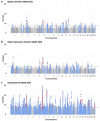This is a preprint.
Potentially causal associations between placental DNA methylation and schizophrenia and other neuropsychiatric disorders
- PMID: 36945560
- PMCID: PMC10029044
- DOI: 10.1101/2023.03.07.23286905
Potentially causal associations between placental DNA methylation and schizophrenia and other neuropsychiatric disorders
Update in
-
Potentially causal associations between placental DNA methylation and schizophrenia and other neuropsychiatric disorders.Nat Commun. 2025 Mar 14;16(1):2431. doi: 10.1038/s41467-025-57760-3. Nat Commun. 2025. PMID: 40087310 Free PMC article.
Abstract
Increasing evidence supports the role of placenta in neurodevelopment and potentially, in the later onset of neuropsychiatric disorders. Recently, methylation quantitative trait loci (mQTL) and interaction QTL (iQTL) maps have proven useful to understand SNP-genome wide association study (GWAS) relationships, otherwise missed by conventional expression QTLs. In this context, we propose that part of the genetic predisposition to complex neuropsychiatric disorders acts through placental DNA methylation (DNAm). We constructed the first public placental cis-mQTL database including nearly eight million mQTLs calculated in 368 fetal placenta DNA samples from the INMA project, ran cell type- and gestational age-imQTL models and combined those data with the summary statistics of the largest GWAS on 10 neuropsychiatric disorders using Summary-based Mendelian Randomization (SMR) and colocalization. Finally, we evaluated the influence of the DNAm sites identified on placental gene expression in the RICHS cohort. We found that placental cis-mQTLs are highly enriched in placenta-specific active chromatin regions, and useful to map the etiology of neuropsychiatric disorders at prenatal stages. Specifically, part of the genetic burden for schizophrenia, bipolar disorder and major depressive disorder confers risk through placental DNAm. The potential causality of several of the observed associations is reinforced by secondary association signals identified in conditional analyses, regional pleiotropic methylation signals associated to the same disorder, and cell type-imQTLs, additionally associated to the expression levels of relevant immune genes in placenta. In conclusion, the genetic risk of several neuropsychiatric disorders could operate, at least in part, through DNAm and associated gene expression in placenta.
Figures







References
-
- Strauss R.S. Effects of the intrauterine environment on childhood growth. Br. Med. Bull. 53, 81–95 (1997). - PubMed
-
- O’Donnell K., O’Connor T. G., & Glover V. Prenatal stress and neurodevelopment of the child: focus on the HPA axis and role of the placenta. Dev. Neurosci. 31, 285–292 (2009). - PubMed
Publication types
LinkOut - more resources
Full Text Sources
Miscellaneous
